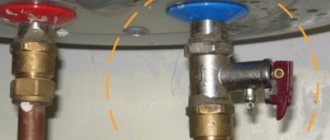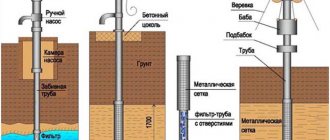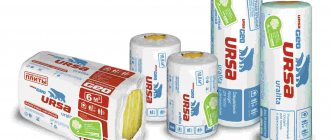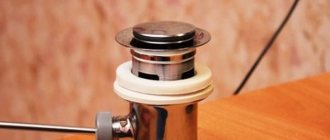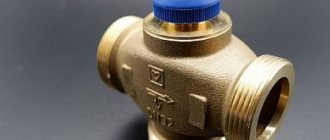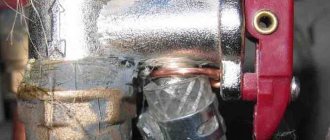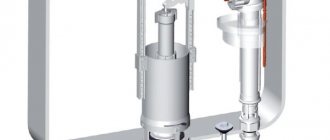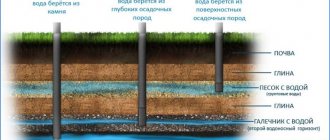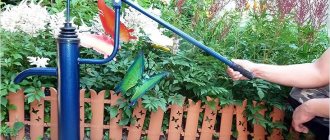Non-return valve for washing machine drain
Currently, a washing machine is an integral attribute in every apartment. Any housewife is interested in keeping her linens crystal clean. The quality of washing depends not only on the characteristics of the machine and powder, but also on the correct connection. The washing machine must not only pump clean water, but also ensure that waste water is discharged into the sewer system. As a rule, there are no problems with water injection. And illiterate organization of drainage can lead to a number of problems. Dirty water from sewer pipes can flow back into your car. To block the reverse flow of water, it is necessary to install a check valve on the drain hose of the washing machine, which is also called an anti-siphon.
Why do you need an antisiphon?
High-quality washing is impossible without an anti-siphon. Its main function is to pass dirty water into the sewer and prevent it from entering back. An anti-siphon is a small pipeline element with a tip for connecting to a hose and a built-in check valve. The diameters of the inlet and outlet pipes are different. Most often, this device is sold complete with a washing machine.
Anti-siphon valve
Without it, high-quality washing is only possible if certain operating conditions are met. The main condition is that the drain hose must be higher than the sewer pipes. Many people organize a drain right next to the floor in order to preserve the interior. This erroneous decision leads to an increase in the siphon effect. But even with a properly connected machine, problems can arise. If the sewer pipes have not been changed for a long time, a “siphon effect” also occurs when draining.
This is quite easy to determine. The operating time increases significantly, the quality of washing decreases, and energy costs increase. These are manifestations of the “siphon effect”. It appears if the drainage is not organized correctly. The diameter of the machine drain hose is much smaller than the diameter of the sewer pipe. Draining leads to a release of pressure, water is pumped out of the drum. The machine is forced to draw water from the water pipe and heat it. As a result, the operating time of the unit increases and water consumption increases. These problems can be avoided by installing a siphon with a check valve.
Operating principle of a check valve
A siphon with a check valve is mounted on the drain pipeline in an arbitrary location. When the drain program is turned on, the pump starts to pump out water. The pressure in the hose increases and water flows freely through the valve. After the drain cycle completes, the water stops flowing and the pressure drops. In this case, the device closes, blocking the passage. A tight connection is formed. In this way, the passage for water to enter the drum from the pipe is blocked. Due to the height difference between the inlet and outlet pipes, the reaction time to pressure changes is minimal.
This is interesting: Which siphon is better for a bath? Types of structures and recommendations for choosing reinforcement
The most commonly used locking device is:
- polypropylene ball;
- spring.
The principle of operation of the antisiphon
The locking mechanism is a small ball of air. When direct fluid pressure is removed, the ball rests against the sealing membrane. When back pressure occurs, the force of pressing the ball against the membrane only increases. Reverse penetration of liquid is not possible.
No ball cleaning required. Special ribs in the valve body serve for self-cleaning of the ball. A siphon with a spring valve uses a spring as the closing mechanism.
The design of the mechanism makes it possible to install it on any section of the pipeline. The installation location does not affect the quality of work.
All valve modifications are made of high-quality durable plastic. Therefore, the devices have a long service life. The service life can only be affected by water quality. Too hard water in the water supply system destroys the elements of the device.
Types of check valves
There are several types of antisiphons for washing machines:
- collapsible (segmental);
- non-separable;
- wall;
- mortise;
- washing
Types of antisiphons
Double check valve
Wall check valve
It is better to choose collapsible devices for houses with hard water. If it gets dirty, it can be dismantled and disassembled. Without cleaning, the device can quickly fail. In addition, only such valves are suitable for certain brands of washing machines (for example, from the manufacturer LG). This is usually stated in the instructions for the washing machine. If the water is of good quality, a non-separable option is quite suitable. It is much cheaper than segment ones.
Non-separable valves are subject to forced replacement. Devices need to be checked and replaced more often with hard water.
Mortise devices are convenient to use when connecting a direct drain into a sewer pipe. To install the valve, a special mortise hole is prepared in the pipe. This connection option is somewhat more complicated.
Wall-mounted ones have the most aesthetic appearance. But they are significantly more expensive than others. It is mounted between the washing machine and the wall. This is the most compact device.
Wall check valve
The washer is not suitable for washing machines. Their purpose is a sink siphon. There are also many models with decorative inserts. Inserts are usually made of high quality stainless steel. But such models are several times more expensive. But it should be remembered that appearance does not affect quality.
There are no special rules when choosing an antisiphon. The main thing is that the device fits the washing machine and the drainage structure. Therefore, first of all, you need to carefully study the machine’s instructions and the design features of the sewer pipes.
DIY installation
Installing the device is not particularly difficult. The installation principle for all varieties is approximately the same:
- connect the siphon to the valve tube (for mortise ones - install it in a pre-prepared cutout in the pipe);
- connect the second output to the drain hose of the washing machine;
- seal all joints with sealant.
Antisiphon tubes have different diameters. Therefore, incorrect connection is completely excluded. The most important thing is to ensure the tightness of all connections.
It must be remembered that in drain mode there is strong vibration of the hose. High-quality connections will help avoid leaks. Before starting, it is necessary to check the operation of the sewer system. If water flow is poor, the pipes need to be cleaned.
This is interesting: How to change pipes in a bathroom with your own hands
Which manufacturers are better
Check valves for washing machines can be purchased at any hardware store. The variety of manufacturers and price range is quite wide. To ensure that the device works for a long time, when purchasing, it is better to give preference to trusted suppliers. The table shows the most common devices from well-known brands.
| Manufacturer | Type | Characteristics |
| Alcaplast, Czech Republic | APS2 | Plastic, ? 32 mm, for any hoses, one-piece |
| Siroflex, Italy | 012677 | Mortise, spring. |
| Merloni, Italy | 95101800 | Mortise, plastic |
| McALPINE, Scotland | WMV-32WH | Plastic, ? 19-25×32, one-piece |
| ANI Plast | P-12/M500/APS2 | Minisiphon (wall-mounted) |
Whether or not to install a siphon with a check valve is up to everyone to decide for themselves. But you should remember that without it it is impossible to organize a drain. The quality of washing decreases, washing time, water and electricity consumption increases. An inexpensive device that is easy to install even without the involvement of specialists will help avoid these problems.
Types of wells for private water supply
The undrinkable water is quite suitable for watering the garden, cleaning and similar needs. It is easier and cheaper to obtain it by constructing a needle well, also called an Abyssinian well. It is a column of thick-walled VGP pipes Ø from 25 to 40 mm.
The Abyssinian well is the easiest and cheapest way to obtain water for the temporary supply of a summer cottage
This is the cheapest and easiest way to obtain water for temporary water supply. For summer residents who need exclusively technical water and only in the summer.
- An igloo well, otherwise known as an Abyssinian well, is the simplest and cheapest way to create a water source for a private home.
- You can drill an Abyssinian well in one day. The only drawback is the average depth of 10 - 12 m, which rarely allows the water to be used for drinking purposes.
- An Abyssinian well can be installed within the house by placing pumping equipment in the basement or utility room.
- The igloo well is excellent for extracting water for watering a garden and maintaining a suburban area.
- Sand wells can supply water for both technical and drinking purposes. It all depends on the specific hydrogeological situation in the suburban area.
- If the water carrier covers a layer of waterproof soil on top, then the water may well be potable.
Aquitard soils that prevent the penetration of water prevent the penetration of domestic wastewater. If the sand containing water does not have natural protection in the form of loam or hard sandy loam, its drinking purpose will most likely have to be forgotten.
The walls of the well are reinforced with a column of steel casing pipes connected to each other by couplings or welds. Recently, polymer casing has been actively used, in demand by private owners due to its affordable price and corrosion resistance.
The design of a well in sand provides for the installation of a filter that prevents gravel and large sand suspension from penetrating into the wellbore.
Constructing a well for sand will cost much more than an Abyssinian well, but is cheaper than drilling a mine in rocky soils
The working part of the well filter must protrude beyond the aquifer at the top and bottom by at least 50 cm. That is. its length must be equal to the sum of the thickness of the aquifer and at least 1 m of reserve.
The diameter of the filter should be 50 mm smaller than the diameter of the casing so that it can be freely immersed and removed from the shaft for cleaning or repair.
Wells whose trunk is buried in rocky limestone can do without a filter and partially without casing. These are the deepest water intake workings, extracting water from cracks in the bedrock.
They last longer than their counterparts buried in sand. They are not characterized by the process of siltation, because There is no clay suspension or small grains of sand in the thickness of the water-bearing soils.
The risk of drilling an artesian well is that a fracture zone with underground water may not be detected
At a depth of more than 100 m, it is permissible to use asbestos-cement pipes or drill a well without casing at all, if there is no need to strengthen the rock walls of the hydraulic structure.
If an artesian well penetrates more than 10 m of fractured rock containing groundwater, then a filter is installed. Its working part must cover the entire thickness supplying water.
The water supply system for an autonomous house with one filter is typical for artesian wells that do not require multi-stage water purification
Necessity of application
If the drain hose is connected to the sewer outlet in violation of plumbing standards, then it is likely that dirty water from the sewer pipe will return to the drum of the washing machine. As a result, at the end of the wash you will end up with stale, foul-smelling laundry. The check valve is designed to prevent such a development of events (which, by the way, is called the “siphon effect”).
A non-return valve or anti-siphon should be installed when it is not possible to install the drain hose at the required height. Another case in which this device cannot be avoided is when the washing machine drain is connected through the sink siphon.
You should also think about installing an anti-siphon if you notice signs of a siphon effect during washing. These include: increased washing time, poorly washed items, increased consumption of water and electricity by the washing machine.
A simple way to install a summer water supply
The entire process of laying a summer water pipeline will not take much time. First of all, decide on its location by choosing from the following options:
- Ground, in which the line is drawn directly along the surface of the soil. You will appreciate the advantages of this solution during installation and dismantling, as they are carried out very quickly and easily. But at the same time, there is always the possibility of system failure due to direct mechanical impact.
- Recessed, which is distinguished by the location of the pipeline itself at a shallow depth in the ground, but all the valves for regulating the water supply remain on the surface. This option is more acceptable due to its reliability. Free access to all elements remains.
Technology
To assemble such a system, follow these steps:
- Design a laying line in advance - a water supply diagram at the dacha, so that the system does not interfere and at the same time is located with a slight slope.
- Install the pumping system.
- Connect it to a water source.
- Place hoses or plastic pipes along the entire fluid supply line to the desired object.
- Connect them using pipes and fittings.
- At a certain distance along the entire length of the pipeline, install shut-off valves to be able to regulate the intensity and supply area.
How does it work?
A check valve is a fairly simple device made of stainless metal or plastic. In appearance, it is a bit like a shut-off valve, and its operating principle is similar. An anti-siphon is needed to regulate the flow of water in the pipe, allowing it to move only in one direction.
Initially, the check valve is in a locked state, but when the drain mode is activated, it opens under the pressure of water. When the drain program is turned off, the valve automatically closes, preventing water from returning.
Models and prices
The names, appearance, country of origin and prices of some valve models are presented in the table below.
| Name | Manufacturer country | Price, rub |
| Kludi 1042705-00 | Germany | 500 |
| Vitra A45137EXP | Türkiye | 595 |
| Elghansa siphon WBT12 | Germany | 1000 |
| Viega 103385 | Germany | 780 |
| Elghansa siphon WBT12-bronze | Germany | 1360 |
| Kludi 1042405-00 | Germany | 1800 |
Kinds
There are several types of check valves on the modern plumbing equipment market. They differ in design features, type of installation and scope of application.
Main types of antisiphons:
- collapsible - a metal device consisting of several parts; this type is convenient because, if necessary, it can be disassembled and cleaned;
- non-removable - monolithic structure made of plastic; considered the most budget option;
- mortise - a valve that is installed directly into the pipe, in place of a piece cut out of it;
- washing – check valve intended for use in drain siphons of sinks and washbasins;
- wall-mounted – a beautiful structure made of chromed metal that is mounted on the wall; the most expensive option of all of the above.
This is interesting: Replacing pipes in the bathroom: how not to make mistakes during repairs
Operating principle of electromagnetic systems
The operating principle of the electromagnetic shut-off valve is based on the physical phenomenon of electromagnetic induction. When current flows through an inductor, a magnetic field arises inside it, acting on a core of magnetic materials with a force applied in the longitudinal direction. This force, depending on the polarity of the applied voltage, tries to pull the core inside the coil or push it out. In this case, the shutter element opens or closes.
Solenoid valve coils can operate on either 5 to 36 volt DC or 220 V AC.
Devices with low control voltage have low power and limited force transmitted to the locking element. This allows the use of low-voltage semiconductor circuits to control them. Such devices are used in low pressure systems of the working medium, on pipelines of small diameters.
Drives operating on alternating current develop much greater forces and can be used on main pipelines of high pressure and large diameters.
Features of use
- Some manufacturers of household appliances add a check valve to the basic configuration of washing machines, but not all do this. Therefore, most likely, you will have to purchase this device yourself in a specialized store.
- If you connect the drain using a check valve, then you do not have to worry about following the recommendations regarding the height of the drain hose. The main thing is to install all elements of the system in such a way that they can be easily accessed in case cleaning or repairs are needed.
- When purchasing a check valve, be prepared for the fact that this device will have to be replaced every few years, as it will be exposed to hard tap water. The better the quality of the product, the longer it will last, but you still shouldn’t overpay - no matter how expensive the device is, sooner or later it will need to be replaced.
Structure of a standard normally closed solenoid valve (220V)
Valves with the simplest design usually have one inlet and one outlet, although options with multiple ports exist.
Most locking devices include the following parts:
- armature spring;
- hole responsible for adjustment;
- coil;
- valve plate;
- main hole;
- diaphragm;
- hole responsible for alignment.
Most solenoid valves include the following parts: armature spring, coil, valve plate, diaphragm.
Normally closed 220V solenoid valves have many useful advantages, including convenience, high response speed, and the ability to control the operation of the system remotely. They are more accurate than manual devices, save time and effort, and improve the safety and efficiency of household appliances.
There are no worm or gear drives in the design. Unlike a gearbox and an electric motor, valves have a simplified structure and a minimum number of moving components, so they are more reliable, have a long service life and are subject to minimal wear.
The high reliability of normally closed solenoid valves for water is also due to other design features. If the remote control fails or the power goes out, you can still use the device, which in this case will act like a regular water tap. To do this, simply turn the control solenoid ¼ turn to the “off” or “on” position.
On a note! The smaller the distance between the electromagnetic core and the stopper, the stronger the electromagnetic field. Moreover, this statement remains unchanged, regardless of the type of voltage and its magnitude.
Solenoid valves have a simplified structure and a minimum number of moving parts.
Installation
Installing a check valve is not a difficult task at all; you can easily handle it yourself, without the help of a master plumber. You can get complete information on installation from the instructions for the device, which you must read, but we will only give brief recommendations.
Antisiphons come in different types, but most are shaped like a tube with two holes. One end of the device must be connected to the sewer (by screwing it into the outlet or cutting it into a pipe), and the other must be connected to the drain hose of the washing machine. To prevent leaks, treat all connections with silicone plumbing sealant.
You can clearly see the valve installation process in the following video.
Signs of a malfunctioning carburetor solenoid valve
The latest carburetors use a solenoid drive to control the fuel supply. How to check the solenoid valve for serviceability?
Its breakdown is determined by the following signs:
- The engine runs unsteadily at low speeds.
- The motor stalls when coasting.
- After turning off the engine, detonation of the working mixture is observed.
Indirect signs of a malfunction are also a decrease in speed when connecting powerful electricity consumers, such as a radio, low or high beam, heated windows.
Tips for choosing
- Experts say that not all models of drain valves are suitable for your washing machine. The service center will help you choose the appropriate antisiphon. You can also seek advice from an experienced technician who specializes in repairing washing machines.
- The best recommendations are for check valves from European manufacturers. The equipment receives a large number of positive reviews from the Italian companies Siroflex and Merloni, as well as from the Czech company Alcaplast.
Should it be replaced with something else?
A check valve for a washing machine is not such a rare product, but it is not always possible to find it in stores, especially if you live in a small town. Therefore, many are interested in the question: is it possible to use something else to prevent the siphon effect?
Unfortunately, the answer to this question will be negative. There are no analogues to the antisiphon yet. To do without it, you will have to organize the drain in such a way that all elements of the system are positioned as expected, and then there will be no siphon effect.
Sources
https://o-vannoy.ru/stiralnaya-mashina/obratnyj-klapan/ https://vannayasovety.ru/tekhnika/obratnyj-klapan-na-sliv.html
